Legacy To Cloud Migration

What is a Legacy to Cloud Migration System?
A Legacy To Cloud Migration system is outdated computing software and/or hardware that is still in use. The system still meets the needs it was originally designed for, but doesn’t allow for growth. What a legacy system does now for the company is all it will ever do. A legacy system’s older technology won’t allow it to interact with newer systems.
As technology advances, most companies find themselves dealing with the issues caused by an existing legacy system. Instead of offering companies the latest capabilities and services — such as cloud computing and better data integration — a legacy system keeps a company in a business rut.
The Best Way to Use Legacy to Cloud Migration Applications
An eye for design and a mind for strategic execution. We focus on making great new digital experiences and helping existing companies refocus on digital
Real Time Visibility
We manage the full technology lifecycle
Intelligence and Automation
We manage the full technology lifecycle
Improved Scalability
We manage the full technology lifecycle
Speed
We manage the full technology lifecycle
What are the benefits of Legacy to cloud migration?
For companies that undertake the process of cloud migration, the cloud can have a massive impact. This includes a reduction in the total cost of ownership (TCO), faster time to delivery, and enhanced opportunities for innovation. With access to the cloud comes agility and flexibility, both of which are imperative to meet changing consumer and market demands.
In recent months, companies have been migrating their services and data to the cloud as they adapt to become elastic digital workplaces to deal with an increase in online demand and remote working. For businesses that have already begun the move to cloud computing, they're accelerating a cloud transformation that will lead the way forward in the years to come.
Benefits of migrating to the cloud include:
- Increased agility and flexibility
- Ability to innovate faster
- Easing of increasing resource demands
- Better managing of increased customer expectations
- Reduction in costs
- Deliver immediate business results
- Simplify IT
- Shift to everything as-a-service
- Better consumption management
- Cloud scalability
- Improved performance

Ready to launch your
next projects?
Let us call. Our team of experienced creatives and developers will listen to you. and Provide a service of high quality.

Problems caused by Legacy to cloud migration systems
1. Maintenance is costly (and futile)
Maintenance is to expected with any system, but the cost of maintaining a legacy system is extensive. Maintenance keeps the legacy system running, but at the same time, the company is throwing good money after bad. The status quo is maintained, but there’s never a chance for growth with the legacy system.
2. Data is stuck in silos
Data silos are a byproduct of legacy systems. Many older systems were never designed to integrate with each other in the first place, and many legacy software solutions are built on frameworks that can’t integrate with newer systems. This means that each legacy system is its own data silo. In addition to siloing the data they contain, legacy systems keep the departments that use them out of data integration happening in the rest of the organization.
3. Compliance is much harder
Organizations today must abide by strict sets of compliance regulations. As these regulations continue to evolve, a legacy system may not be equipped to meet them. Compliance regulations like the GDPR, for example, require a company to know (and prove) what customer data they have, where it is, and who is accessing it.
4. Security gets weaker by the day
A data breach can cost a company dearly, and legacy systems are more vulnerable to hackers than newer systems. Legacy systems by definition have outdated data security measures, such as hard-coded passwords. That wasn’t a problem when the system was built, but it is now. A legacy system not only leaves a company behind with old technology, it can also seriously damage a company’s reputation by putting data at risk of a breach.
5. New systems don’t integrate
As a company matures, adding new systems is necessary to stay competitive in today’s world. But the older technology of a legacy system may not be able to interact with a new system. A department still using a legacy system won’t receive all the benefits that a new system offers.
The key to updating Legacy to cloud migration systems: successful data migration
A successful data migration includes:
- Extracting the existing data. Data in existing legacy systems might be siloed, splintered, duplicated, or incomplete. It may exist in a variety of data stores and in a variety of formats. Migrating data out of a legacy system starts with making sure it can all be extracted safely.
- Transforming data so it matches the new formats. The data is transformed to the new system’s requirements through data mapping. Rarely does data from legacy systems do an exact mapping to the new system. This step is vital to ensure that the new system understands the data from the legacy system.
- Cleansing the data to address any quality issues. During the migration process is a good time to clean data by getting rid of duplications, incomplete data, and data that is not properly formatted. A legacy system with phone numbers that contains dashes won’t work with a new system that doesn’t allow for them.
- Validating the data to make sure the move goes as planned. Once data is extracted, transformed, and cleaned, a sample set of data is imported to test for problems and errors. This weeds out potential issues before the new system goes live.
- Loading the data into the new system. The final step to a successful data migration is loading all the data into the new system so it is ready for use.

Get In Touch
ADDRESS:
AWN SOLUTION LLC
3490 US – 1 #109,
Princeton, NJ, 08540 USA
OPENING HOURS:
12 Noon to 9 PM
We deliver pioneering digital solutions
Development
Branding
IT Services
UX Design
UX Design

Register Office
AWN SOLUTION PRIVATE LIMITED
No 1 Pattamal Street, Krishnapuram
Ambattur, Chennai – 600053
Branch Office
AWN SOLUTION LLC
3490 US – 1 #109,
Princeton, NJ, 08540 USA
© AWN SOLUTIONS 2022. All Rights Reserved.







